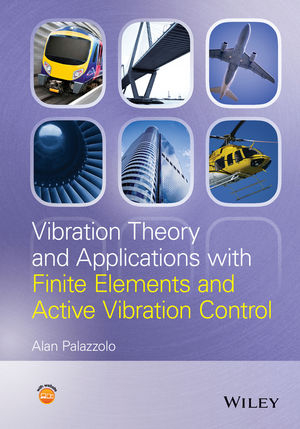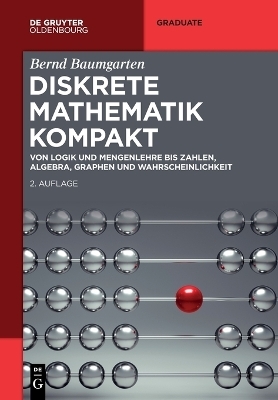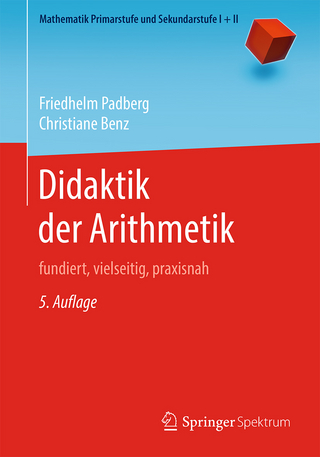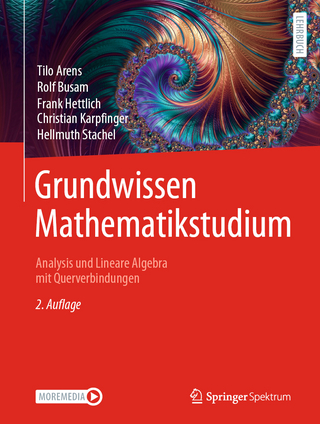
Vibration Theory and Applications with Finite Elements and Active Vibration Control
John Wiley & Sons Inc (Verlag)
978-1-118-35080-5 (ISBN)
- Titel z.Zt. nicht lieferbar
- Versandkostenfrei innerhalb Deutschlands
- Auch auf Rechnung
- Verfügbarkeit in der Filiale vor Ort prüfen
- Artikel merken
Alan Palazzolo, Professor of Mechanical Engineering, Texas A&M University. Professor Palazzolo worked in industry prior to returning to academic research and gaining full Professorship in Mechanical Engineering in 1999.?He has written extensively for international journals, books and conference proceedings and has been the recipient of numerous awards throughout his professional career. His research interests include vibrations, nonlinear vibrations, controls, rotordynamics and finite elements. He is presently an Associate Editor of ASME Journal of Vibrations.
Preface xv
Acknowledgments and Dedication xxi
About the Companion Website xxiii
List of Acronyms xxv
1 Background, Motivation, and Overview 1
1.1 Introduction 1
1.2 Background 1
1.2.1 Units 5
1.3 Our Vibrating World 6
1.3.1 Small-Scale Vibrations 6
1.3.2 Medium-Scale (Mesoscale) Vibrations 8
1.3.3 Large-Scale Vibrations 8
1.4 Harmful Effects of Vibration 9
1.4.1 Human Exposure Limits 9
1.4.2 High-Cycle Fatigue Failure 11
1.4.3 Rotating Machinery Vibration 21
1.4.4 Machinery Productivity 27
1.4.5 Fastener Looseness 28
1.4.6 Optical Instrument Blurring 28
1.4.7 Ethics and Professional Responsibility 29
1.4.8 Lifelong Learning Opportunities 29
1.5 Stiffness, Inertia, and Damping Forces 29
1.6 Approaches for Obtaining the Differential Equations of Motion 34
1.7 Finite Element Method 35
1.8 Active Vibration Control 37
1.9 Chapter 1 Exercises 37
1.9.1 Exercise Location 37
1.9.2 Exercise Goals 37
1.9.3 Sample Exercises: 1.6 and 1.11 38
References 38
2 Preparatory Skills: Mathematics, Modeling, and Kinematics 41
2.1 Introduction 41
2.2 Getting Started with MATLAB and MAPLE 42
2.2.1 MATLAB 42
2.2.2 MAPLE (Symbolic Math) 45
2.3 Vibration and Differential Equations 50
2.3.1 MATLAB and MAPLE Integration 50
2.4 Taylor Series Expansions and Linearization 56
2.5 Complex Variables (CV) and Phasors 60
2.6 Degrees of Freedom, Matrices, Vectors, and Subspaces 63
2.6.1 Matrix–Vector Related Definitions and Identities 69
2.7 Coordinate Transformations 75
2.8 Eigenvalues and Eigenvectors 79
2.9 Fourier Series 80
2.10 Laplace Transforms, Transfer Functions, and Characteristic Equations 83
2.11 Kinematics and Kinematic Constraints 86
2.11.1 Particle Kinematic Constraint 86
2.11.2 Rigid Body Kinematic Constraint 90
2.11.3 Assumed Modes Kinematic Constraint 96
2.11.4 Finite Element Kinematic Constraint 98
2.12 Dirac Delta and Heaviside Functions 100
2.13 Chapter 2 Exercises 101
2.13.1 Exercise Location 101
2.13.2 Exercise Goals 101
2.13.3 Sample Exercises: 2.9 and 2.17 101
References 102
3 Equations of Motion by Newton’s Laws 103
3.1 Introduction 103
3.2 Particle Motion Approximation 103
3.3 Planar (2D) Rigid Body Motion Approximation 107
3.3.1 Translational Equations of Motion 107
3.3.2 Rotational Equation of Motion 108
3.4 Impulse and Momentum 129
3.4.1 Linear Impulse and Momentum 129
3.4.2 Angular Impulse and Momentum 134
3.5 Variable Mass Systems 138
3.6 Chapter 3 Exercises 140
3.6.1 Exercise Location 140
3.6.2 Exercise Goals 140
3.6.3 Sample Exercises: 3.8 and 3.21 141
References 141
4 Equations of Motion by Energy Methods 143
4.1 Introduction 143
4.2 Kinetic Energy 143
4.2.1 Particle Motion 143
4.2.2 Two-Dimensional Rigid Body Motion 144
4.2.3 Constrained 2D Rigid Body Motion 146
4.3 External and Internal Work and Potential Energy 147
4.3.1 External Work and Potential Energy 150
4.4 Power and Work–Energy Laws 151
4.4.1 Particles 151
4.4.2 Rigid Body with 2D Motion 153
4.5 Lagrange Equation for Particles and Rigid Bodies 157
4.5.1 Derivation of the Lagrange Equation 158
4.5.2 System of Particles 160
4.5.3 Collection of Rigid Bodies 162
4.5.4 Potential, Circulation, and Dissipation Functions 168
4.5.5 Summary for Lagrange Equation 182
4.5.6 Nonconservative Generalized Forces and Virtual Work 183
4.5.7 Effects of Gravity for the Lagrange Approach 195
4.5.8 “Automating” the Derivation of the LE Approach 201
4.6 LE for Flexible, Distributed Mass Bodies: Assumed Modes Approach 211
4.6.1 Assumed Modes Kinetic Energy and Mass Matrix Expressions 212
4.6.2 Rotating Structures 215
4.6.3 Internal Forces and Strain Energy of an Elastic Object 216
4.6.4 The Assumed Modes Approximation 219
4.6.5 Generalized Force for External Loads Acting on a Deformable Body 221
4.6.6 Assumed Modes Model Generalized Forces for External Load Acting on a Deformable Body 221
4.6.7 LE for a System of Rigid and Deformable Bodies 223
4.7 LE for Flexible, Distributed Mass Bodies: Finite Element Approach—General Formulation 267
4.7.1 Element Kinetic Energy and Mass Matrix 267
4.7.2 Element Stiffness Matrix 269
4.7.3 Summary 272
4.8 LE for Flexible, Distributed Mass Bodies: Finite Element Approach—Bar/Truss Modes 275
4.8.1 Introduction 275
4.8.2 1D Truss/Bar Element 276
4.8.3 1D Truss/Bar Element: Element Stiffness Matrix 276
4.8.4 1D Truss/Bar Element: Element Mass Matrix 277
4.8.5 1D Truss/Bar Element: Element Damping Matrix 277
4.8.6 1D Truss/Bar Element: Generalized Force Vector 278
4.8.7 1D Truss/Bar Element: Nodal Connectivity Array 279
4.8.8 System of 1D Bar Elements: Matrix Assembly 280
4.8.9 Incorporation of Displacement Constraint 285
4.8.10 Modeling of 2D Trusses 289
4.8.11 2D Truss/Bar Element: Element Stiffness Matrix 292
4.8.12 2D Truss/Bar Element: Element Mass Matrix 293
4.8.13 2D Truss/Bar Element: Element Damping Matrix 294
4.8.14 2D Truss/Bar Element: Element Force Vector 295
4.8.15 2D Truss/Bar Element: Element Action Vector 296
4.8.16 2D Truss/Bar Element: Degree of Freedom Connectivity Array and Matrix Assembly 296
4.8.17 2D Truss/Bar Element: Rigid Region Modeling for 2D Trusses 303
4.9 Chapter 4 Exercises 306
4.9.1 Exercise Location 306
4.9.2 Exercise Goals 307
4.9.3 Sample Exercises: 4.43 and 4.52 307
References 308
5 Free Vibration Response 309
5.1 Introduction 309
5.2 Single Degree of Freedom Systems 309
5.2.1 SDOF Eigenvalues (Characteristic Roots) 310
5.2.2 SDOF Initial Condition Response 311
5.2.3 Log Decrement: A Measure of Damping—Displacement-Based Measurement 313
5.2.4 Log Decrement: A Measure of Damping—Acceleration-Based Measurement 315
5.3 Two-Degree-of-Freedom Systems 319
5.3.1 Special Case I (C=G=KC = 0) (Undamped, Nongyroscopic, and Noncirculatory Case) 322
5.3.2 Special Case IIC=KC = 0 (Undamped, Gyroscopic, and Noncirculatory Case) 332
5.3.3 Special Case III C=G=0 (Undamped, Nongyroscopic, and Circulatory Case) 342
5.4 N-Degree-of-Freedom Systems 346
5.4.1 General Identities 346
5.4.2 Undamped, Nongyroscopic, and Noncirculatory Systems—Description 346
5.4.3 Undamped, Nongyroscopic, and Noncirculatory Systems—Solution Form 347
5.4.4 Undamped, Nongyroscopic, and Noncirculatory Systems—Orthogonality 349
5.4.5 Undamped, Nongyroscopic, and Noncirculatory Systems—IC Response 351
5.4.6 Undamped, Nongyroscopic, and Noncirculatory Systems—Rigid Body Modes 352
5.4.7 Summary 353
5.4.8 Undamped, Nongyroscopic, and Noncirculatory Systems—Response to an IC Modal Displacement Distribution 363
5.4.9 Orthogonally Damped, Nongyroscopic, and Noncirculatory Systems—Description 364
5.4.10 Orthogonally Damped, Nongyroscopic, and Noncirculatory Systems—Eigenvalues and Eigenvectors 365
5.4.11 Orthogonally Damped, Nongyroscopic, and Noncirculatory Systems—IC Response 366
5.4.12 Orthogonally Damped, Nongyroscopic, and Noncirculatory Systems—Determination of C0 367
5.4.13 Nonorthogonally Damped System with Symmetric Mass, Stiffness, and Damping Matrices 377
5.4.14 Undamped, Gyroscopic, and Noncirculatory Systems—Description 379
5.4.15 Undamped, Gyroscopic, and Noncirculatory Systems—Eigenvalues and Eigenvectors 380
5.4.16 Undamped, Gyroscopic, and Noncirculatory Systems—Biorthogonality 385
5.4.17 General Linear Systems—Description 388
5.4.18 General Linear Systems—Biorthogonality 389
5.5 Infinite Dof Continuous Member Systems 390
5.5.1 Introduction 390
5.5.2 Transverse Vibration of Strings and Cables 390
5.5.3 Axial Vibration of a Uniform Bar 394
5.5.4 Torsion of Bars 396
5.5.5 Euler–Bernoulli (Classical) Beam Theory 400
5.5.6 Timoshenko Beam Theory 404
5.6 Unstable Free Vibrations 408
5.6.1 Oil Film Bearing-Induced Instability 411
5.7 Summary 418
5.8 Chapter 5 Exercises 418
5.8.1 Exercise Location 418
5.8.2 Exercise Goals 418
5.8.3 Sample Exercises: 5.25 and 5.35 419
References 419
6 Vibration Response Due to Transient Loading 421
6.1 Introduction 421
6.2 Single Degree of Freedom Transient Response 421
6.2.1 Direct Analytical Solution Method 422
6.2.2 Laplace Transform Method 428
6.2.3 Convolution Integral 434
6.2.4 Response to Successive Disturbances 438
6.2.5 Pulsed Excitations 440
6.2.6 Response Spectrum 444
6.3 Modal Condensation of Ndof: Transient Forced Vibrating Systems 451
6.3.1 Undamped and Orthogonally Damped Nongyroscopic, Noncirculatory Systems 452
6.3.2 Unconstrained Structures 465
6.3.3 Base Excitation 475
6.3.4 Participation Factor and Modal Effective Mass 477
6.3.5 General Nonsymmetric, Nonorthogonal Damping Models 488
6.4 Numerical Integration of Ndof Transient Vibration Response 493
6.4.1 Second-Order System NI Algorithms 494
6.4.2 First-Order System NI Algorithms 500
6.5 Summary 521
6.6 Chapter 6 Exercises 522
6.6.1 Exercise Location 522
6.6.2 Exercise Goals 522
6.6.3 Sample Exercises: 6.18 and 6.21 522
References 523
7 Steady-State Vibration Response to Periodic Loading 525
7.1 Introduction 525
7.2 Complex Phasor Approach 525
7.3 Single Degree of Freedom Models 527
7.3.1 Class I (f(t) 0, y(t) = 0): No Support Excitation—Only External Forcing 529
7.3.2 Class II (f(t) = 0, y(t) 0): Only Support Excitation—No External Forcing 535
7.3.3 Half Power Point Damping Identification 538
7.3.4 Phase Slope Damping Identification 541
7.3.5 Accurate Measurement of ωn 541
7.3.6 Experimental Parameter Identification: Receptances 543
7.3.7 Steady-State Harmonic Response of a Jeffcott Rotor and Rotor Balancing 545
7.3.8 Single Plane Influence Coefficient Balancing 549
7.3.9 Related American Petroleum Institute Standards for Balancing 551
7.3.10 Response of an SDOF Oscillator to Nonsinusoidal, Periodic Excitation 552
7.3.11 Forced Harmonic Response with Elastomeric Stiffness and Damping 556
7.4 Two Degree of Freedom Response 559
7.4.1 Vibration Absorber: Principles 560
7.4.2 Vibration Absorber: Mass Ratio Effect 563
7.5 N Degree of freedom Steady-State Harmonic Response 566
7.5.1 Direct Approach 566
7.5.2 Modal Approach 570
7.5.3 Receptances 572
7.5.4 Receptance-Based Synthesis 575
7.5.5 Dominance of a Single Mode in the Steady-State Harmonic Response 577
7.5.6 Receptance-Based Modal Parameter Identification: Method I 578
7.5.7 Receptance-Based Modal Parameter Identification: Method II 585
7.5.8 Modal Assurance Criterion for Mode Shape Correlation 590
7.6 Other Phasor Ratio Measures of Steady-State Harmonic Response 591
7.7 Summary 593
7.8 Chapter 7 Exercises 593
7.8.1 Exercise Location 593
7.8.2 Exercise Goals 594
7.8.3 Sample Exercises: 7.9 and 7.23 594
References 594
8 Approximate Methods for Large-Order Systems 595
8.1 Introduction 595
8.2 Guyan Reduction: Static Condensation 596
8.3 Substructures: Superelements 608
8.4 Modal Synthesis 609
8.4.1 Uncoupled System Equations 610
8.4.2 Coupled System Equations: Displacement Compatibility at Junction 611
8.4.3 Coupled System Equations: Subspace Condensation 611
8.5 Eigenvalue/Natural Frequency Changes for Perturbed Systems 620
8.5.1 Undamped, Nongyroscopic, Noncirculatory M and K Type Systems 620
8.5.2 Orthogonally Damped Systems 624
8.5.3 Rayleigh’s Quotient 631
8.6 Summary 633
8.7 Chapter 8 Exercises 634
8.7.1 Exercise Location 634
8.7.2 Exercise Goals 634
8.7.3 Sample Exercises 8.4 and 8.13 634
References 635
9 Beam Finite Elements for Vibration Analysis 637
9.1 Introduction 637
9.2 Modeling 2D Frame Structures with Euler–Bernoulli Beam Elements 637
9.2.1 2D Frame Element Stiffness Matrix and Strain Energy: Transverse Deflection 639
9.2.2 2D Frame Element Stiffness Matrix and Strain Energy: Axial Deflection 641
9.2.3 2D Frame Element Stiffness Matrix and Strain Energy 642
9.2.4 2D Frame Element Mass Matrix 642
9.2.5 2D Frame Element Force Vector 644
9.2.6 2D Frame Element Stiffness and Mass Matrices and Force Vector: Transformation to Global Coordinates 646
9.2.7 2D Frame: Beam Element Assembly Algorithm 654
9.2.8 Imposed Support Excitation Modeling 666
9.3 Three-Dimensional Timoshenko Beam Elements: Introduction 670
9.4 3D Timoshenko Beam Elements: Nodal Coordinates 672
9.5 3D Timoshenko Beam Elements: Shape Functions, Element Stiffness, and Mass Matrices 679
9.5.1 Strain–Displacement Relations and Shear Form Factors 681
9.5.2 x1 −x2 Plane, Translational Differential Equations, Shape Functions, and Stiffness and Mass Matrices 684
9.5.3 x1 −x3 Plane, Translational Differential Equations, Shape Functions, and Stiffness and Mass Matrices 691
9.5.4 Axial (Longitudinal) x1 Differential Equation, Shape Functions, and Stiffness and Mass Matrices 696
9.5.5 Torsional θ1 Differential Equation, Shape Functions, and Stiffness and Mass Matrices 698
9.5.6 Twelve-Dof Element Stiffness Matrix 700
9.5.7 Twelve-Dof Element Mass Matrix 703
9.6 3D Timoshenko Beam Element Force Vectors 704
9.6.1 Axial Loads 706
9.6.2 Torsional Loads 706
9.6.3 x1 −x2 Plane Loads 707
9.6.4 x1 −x3 Plane Loads 709
9.6.5 Element Load Vector 711
9.7 3D Frame: Beam Element Assembly Algorithm 713
9.8 2D Frame Modeling with Timoshenko Beam Elements 725
9.9 Summary 748
9.10 Chapter 9 Exercises 749
9.10.1 Exercise Location 749
9.10.2 Exercise Goals 749
9.10.3 Sample Exercises: 9.4 and 9.15a 749
References 750
10 2D Planar Finite Elements for Vibration Analysis 751
10.1 Introduction 751
10.2 Plane Strain (Pε) 751
10.3 Plane Stress (Pσ) 753
10.4 Plane Stress and Plane Strain: Element Stiffness and Mass Matrices and Force Vector 754
10.4.1 External Forces 760
10.4.2 Concentrated Forces 760
10.4.3 General Volumetric Loading 761
10.4.4 Edge Loads 762
10.5 Assembly Procedure for 2D, 4-Node, Quadrilateral Elements 763
10.6 Computation of Stresses in 2D Solid Elements 768
10.6.1 Interior Stress Determination 768
10.6.2 Surface Stresses 770
10.7 Extra Shape Functions to Improve Accuracy 774
10.8 Illustrative Example 776
10.9 2D Axisymmetric Model 786
10.9.1 Axisymmetric Model Stresses and Strains 786
10.9.2 4-Node, Bilinear Axisymmetric Element 788
10.10 Automated Mesh Generation: Constant Strain Triangle Elements 801
10.10.1 Element Stiffness Matrix 803
10.10.2 Element Mass Matrix 803
10.10.3 System Matrix Assembly 804
10.11 Membranes 810
10.11.1 Kinetic Energy and Element Mass Matrix 810
10.11.2 Strain Potential Energy and Element Stiffness Matrix 811
10.11.3 Matrix Assembly 812
10.12 Banded Storage 815
10.13 Chapter 10 Exercises 820
10.13.1 Exercise Location 820
10.13.2 Exercise Goals 821
10.13.3 Sample Exercises: 10.5 and 10.8 821
References 822
11 3D Solid Elements for Vibration Analysis 823
11.1 Introduction 823
11.2 Element Stiffness Matrix 825
11.2.1 Shape Functions 825
11.2.2 Element Stiffness Matrix Integral and Summation Forms 828
11.3 The Element Mass Matrix and Force Vector 835
11.3.1 Element Mass Matrix 836
11.3.2 Element External Force Vector 836
11.3.3 Force Vector: Concentrated Nodal Forces 837
11.3.4 Force Vector: Volumetric Loads 838
11.3.5 Force Vector: Face Loading 839
11.4 Assembly Procedure for the 3D, 8-Node, Hexahedral Element Model 842
11.5 Computation of Stresses for a 3D Hexahedral Solid Element 846
11.5.1 Computation of Interior Stress 846
11.5.2 Computation of Surface Stresses 848
11.5.3 Coordinate Transformation 849
11.5.4 Geometry Mapping in Surface Tangent Coordinates 850
11.5.5 Displacements in the Surface Tangent Coordinate System 851
11.5.6 Strains in the Surface Tangent Coordinate System 851
11.5.7 Surface Stresses Obtained from Cauchy’s Boundary Formula 852
11.5.8 Surface Stresses Obtained from the Constitutive Law and Surface Strains 853
11.5.9 Summary of Surface Stress Computation 854
11.6 3D Solid Element Model Example 856
11.7 3D Solid Element Summary 864
11.8 Chapter 11 Exercises 865
11.8.1 Exercise Location 865
11.8.2 Exercise Goals 865
11.8.3 Sample Exercises: 11.2 and 11.3 865
References 866
12 Active Vibration Control 867
12.1 Introduction 867
12.2 AVC System Modeling 871
12.3 AVC Actuator Modeling 874
12.4 System Model with an Infinite Bandwidth Feedback Approximation 878
12.4.1 Closed-Loop Feedback Controlled System Model 882
12.5 System Model with Finite Bandwidth Feedback 886
12.6 System Model with Finite Bandwidth Feedback and Lead Compensation 893
12.6.1 Transfer Function Approach 893
12.6.2 State Space Approach 897
12.7 Sensor/Actuator Noncollocation Effect on Vibration Stability 901
12.8 Piezoelectric Actuators 907
12.8.1 Piezoelectric Stack Actuator 908
12.8.2 Piezoelectric Layer (Patch) Actuator 915
12.9 Summary 923
12.10 Chapter 12 Exercises 923
12.10.1 Exercise Location 923
12.10.2 Exercise Goals 923
12.10.3 Sample Exercise: 12.1 923
References 924
Appendix A Fundamental Equations of Elasticity 927
Index 941
| Erscheint lt. Verlag | 21.3.2016 |
|---|---|
| Verlagsort | New York |
| Sprache | englisch |
| Maße | 183 x 254 mm |
| Gewicht | 1701 g |
| Themenwelt | Mathematik / Informatik ► Mathematik |
| Technik ► Maschinenbau | |
| ISBN-10 | 1-118-35080-4 / 1118350804 |
| ISBN-13 | 978-1-118-35080-5 / 9781118350805 |
| Zustand | Neuware |
| Haben Sie eine Frage zum Produkt? |
aus dem Bereich


